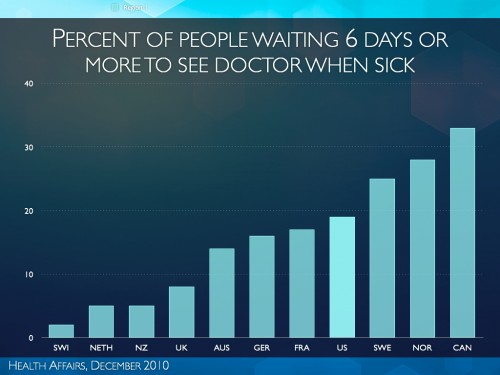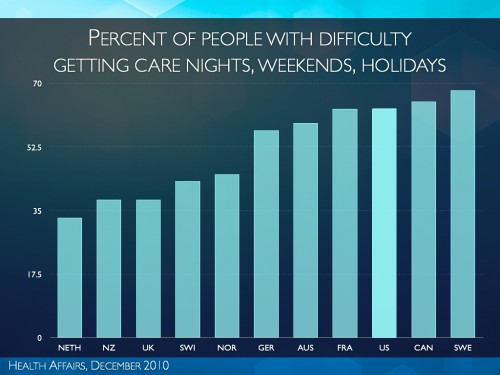Suppose you’ve just found out that you or a loved one has prostate cancer, ...Nearly every urologist would recommend radical surgery to remove the organ. Sounds reasonable, doesn’t it?
But let’s look at the numbers... Prostate cancer is slow-moving; more people die with it than from it. According to one 2004 study, for every 48 prostate surgeries performed, only one patient benefits — the other 47 patients would have lived just as long without surgery... Moreover, the 47 who didn’t need the surgery are often left with an array of unpleasant and irreversible side effects, including incontinence, impotence and loss of sexual desire. The likelihood of one of these side effects is over 50 percent — 24 of our 47 will have at least one. This means a patient is 24 times more likely to experience the side effect than the cure.
...the “risk for disease,” ...is important to untangling disease statistics. Say a drug promises to reduce your risk of fatal illness X by 50 percent. Sounds great, doesn’t it? But suppose there was only a one-in-1,000 chance that you’d get the disease to begin with: reducing your risk by 50 percent means that you’ll now have a one-in-2,000 chance of getting it. Most medications have side effects, and the likelihood of these may far exceed that of being helped by the medication. For example, the “number needed to treat” for a particular cholesterol-lowering drug is 300. (For every 300 people taking it, only one heart attack is prevented.) The drug has a 5 percent probability of side effects, including severe muscle and joint pain and gastrointestinal distress. Thus, for every person helped, 15 people (5 percent of 300) will experience side effects and not be cured. In other words, anyone taking the drug is 15 times more likely to experience the unwanted effects of the medication than the beneficial ones.
Of course, none of us want to think of ourselves as a statistic... studies by cognitive psychologists have shown that our brains are not configured to think statistically, whether the question is how to find the best price on paper towels or whether to have back surgery. In one famous study, Amos Tversky and Daniel Kahneman found that even doctors and statisticians made an astonishing number of inference errors in mock cases; if those cases had been real, many people would have died needlessly. The problem is that our brains overestimate the generalizability of anecdotes. Scientists call anecdotes the “n of 1,” pseudo-experiments with no controls and only one subject. The power of modern scientific method comes from random assignment of treatment conditions; some proportion of people will get better by doing nothing, and without a controlled experiment it is impossible to tell whether that homeopathic thistle tea that helped Aunt Marge is really doing anything.
...Returning to prostate surgery, consider that six weeks is the ...recovery period. Coincidentally, the operation will, on average, add six weeks to your life. (This averages across the 47 people who had no benefit from the operation and the one person who did.) To my way of thinking, the decision then becomes this: When do you want to “spend” those six weeks? When you’re relatively young and feeling well, or at the end of your life, when you’re old and only dimly aware of your surroundings?
GROOPMAN and HARTZBAND @ WSJ:
Consider the case of Susan Powell..., a nurse's assistant now in her 50s. She had been healthy all her life, but when she turned 45, she decided to see a primary-care doctor. Susan ate healthy foods and was physically active, but she was a bit overweight, and her blood tests showed that she had high cholesterol. Her doctor prescribed a statin drug... Statins are among the most commonly prescribed medications in the world. In the U.S. alone, more than 25 million people take the drugs to lower their cholesterol, ...a key factor leading to heart attack and stroke. Soon after seeing her doctor, Susan spoke with an acquaintance at church who had developed muscle pain after starting to take a statin. Susan also thought of her father, who had high cholesterol and never took ...medication... "People take too many pills," he often told his children. He lived a long, full and active life.
Susan decided not to take the statin.
Many people decline treatment because they know someone who suffered from side effects... Stories deeply affect all of us, and they can make real the risks and benefits that might otherwise seem abstract—but they can also distort our vision by making the rare appear routine.
Statistics can help to put lessons drawn from stories into a larger context, letting us make a more considered choice...
At Susan's follow-up appointment..., her doctor told her that "by taking a statin pill, you'll reduce your risk of a heart attack over the next 10 years by as much as 30%." The risk of side effects, she continued, was very small, and the benefits far outweighed the risk. Susan promised to give it serious thought.
She continued to search for information, reading everything she could about cholesterol. What caught her eye was a ... "10-Year Heart Attack Risk Calculator."
She entered her age, total cholesterol number of 240, and "good" cholesterol (HDL) of 37. She was not a smoker, her blood pressure was fine, and she was on no medications. The result: "Risk Score: 1%: Means 1 of 100 people with this level of risk will have a heart attack in the next 10 years."
This means that 99 of 100 people like me won't have a heart attack in the next 10 years, Susan told herself. She started to feel much better. She had found a key number in health literacy: her risk for disease without treatment.
Without treatment, Susan's risk for a heart attack was 1 in 100. If 1 in 100 women has a heart attack, that means... 3 in 300. The statin treatment reduces risk by 30%, or about one-third.
Let's apply that benefit to a group of 300 women like Susan, where three would have a heart attack without taking statins. If we treat them all, we would prevent one heart attack—because we protect one-third of those three. The other two women would still have a heart attack despite taking the medicine. The remaining 297 would not have had a heart attack even without the medication, so they wouldn't benefit from taking it.
This statistic comes as a surprise to many people. When you hear that a statin lowers Susan's risk by 30%, it sounds as if she is at a 100% risk of suffering a heart attack if she doesn't take the medication.
Another component of health literacy is understanding the risks of a therapy. Statins cause muscle pain in 1% to 10% of people who take them. However, if we "flip" the frame, the number without any side effects is 90 to 99 out of 100, a much more reassuring statistic.
Advertisements for drugs ...are designed to communicate a compelling tale. ...In 2007, a team of researchers from the UCLA Medical Center and other medical centers studied prescription drug ads broadcast on national networks. They found that the average American TV viewer sees over 1,000 prescription drug ads in the space of a year. That's 16 hours all told—much more time than the average person spends with his or her primary-care physician.
The study concluded that the large majority of TV ads fail to fulfill an educational purpose. But they clearly work, ...: Every $1,000 spent on advertising translated into 24 new prescriptions...
Another illuminating study ...examined the impact of printed drug ads on patient preferences. One group was given actual ads. A second group received the same ads, except that the brief summary at the end of the text was replaced by a "drug-facts box." [like the nutritional facts box on packaged foods] The box presented information in a clear, accessible fashion, similar to the ...the benefits and risks of a statin for Susan [presented above].
The results of the Dartmouth research are impressive. Nearly two-thirds of the group that saw the original ads overestimated the benefits... They believed it was 10 times more effective than it actually was. But nearly three-quarters of the participants who saw the information in the drug-facts box correctly assessed the actual benefits...
Even more striking was another finding. When people were given readily understandable information about the statin's actual benefit in preventing future heart disease, nearly twice as many said they wouldn't take the drug in light of its side effects. When given clearer information, the patients weighed the risks and benefits differently ...and were less likely to take the medication.

